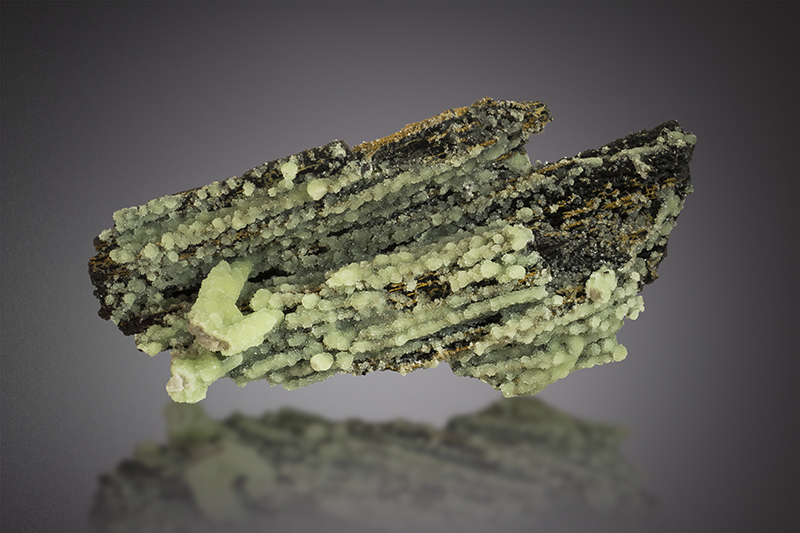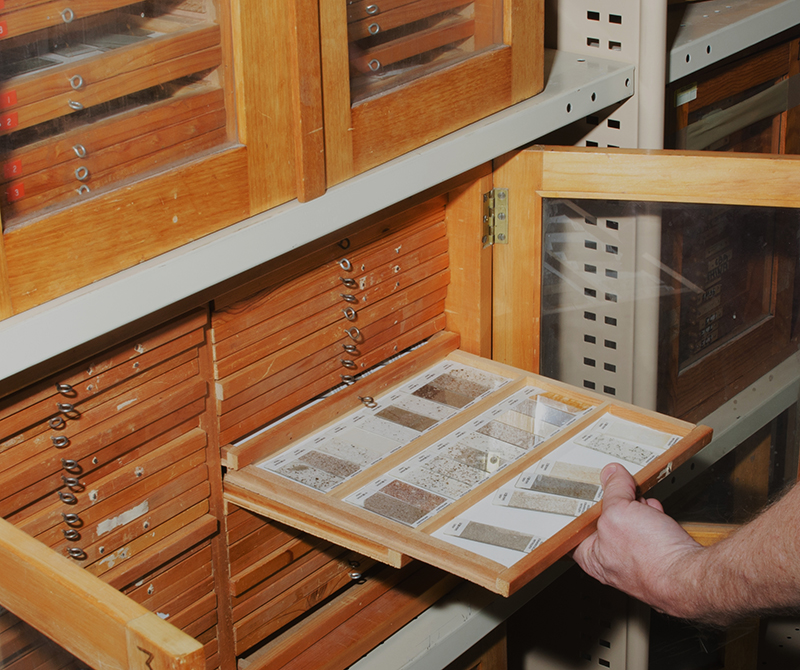About the Collection
Page last updated:8 January 2025
Geoscience Australia houses world-class mineral, meteorite, fossil, and rock thin section specimens within the National Mineral & Fossil Collection. The collection is of scientific, historic, aesthetic, and social significance.
The collection contains approximately:
- 15,000 gem, mineral and meteorite specimens from localities in Australia and across the globe.
- 45,000 published palaeontological specimens contained in the Commonwealth Palaeontological Collection (CPC).
- 1,000,000 unpublished fossils in a ‘Bulk Fossil’ collection.
- 250,000 rock thin section slides.
- 200 historical geoscience instruments including, cartography, geophysical, and laboratory equipment.
History
During the 1920s, the first rock and fossil specimens were accessioned into what was known at the time as the 'fossil and ACT rock reference collection'. The collection has subsequently expanded over the years through field excursions, purchases, exchanges, donations and gifts. The collection was initially a repository used by geologists undertaking fieldwork around the Australian Capital Territory to better understand the regional geology. As Geoscience Australia's work has evolved to encompass a wider range of activities–including mineral and energy resources assessments – the collection has grown and become more diverse.
Mineral specimens
The mineral collection of the National Mineral and Fossil Collection formally commenced in 1940 with the transfer of mineral specimens from the Australian Museum to the Mineral Resources Survey (the first Commonwealth geological organisation) at the request of Dr Walter Woolnough, the Commonwealth Geological Advisor.
During the early 1940s, the focus of the Mineral Resources Survey shifted to a Strategic Minerals program with many samples being added through dedicated field excursions. Following the formation of the Bureau of Mineral Resources in 1946, many mineral specimens were collected by the Bureau's geologists, including muscovite, uranium, and iron ore, all significant to the Australian economy of the time. The collection continued to grow with the purchase of several large collections during the following decades, representing locations across Australia and the globe. One notable collection was that of Albert 'Flossie' Campbell, which was purchased in 1963 and comprises fine specimens of approximately 1,000 minerals from Broken Hill, New South Wales.
Fossil specimens
The National Mineral and Fossil Collection and the Commonwealth Paleontological Collection includes the original wooden cabinets from the early 1900s, full of fossil specimens collected by the first Commonwealth palaeontologist, Frederick Chapman. His primary focus was on microfossils known as foraminifera, but he also collected fossils of all kinds from Victoria. The collection includes fossil specimens collected from the 1910s until the end of the 20th century, when palaeontological work was directed towards discovering oil and coal in and around Australia, including in Papua New Guinea which was an Australian territory at the time.
Many specimens in the collection are 'type' specimens, which have been published in scientific journals and now form an essential scientific reference, these include many vertebrate, invertebrate and plant fossils as well as microfossils. As with all significant fossils, this collection is safeguarded under the Protection of Movable Cultural Heritage Act 1986.
Thin Section Slides
Geoscience Australia holds many decades of petrographic thin sections prepared from rock samples . These have been collected primarily from within Australia as part of our work programs. Thin sections are microscope slides that contain a very thin slice of a rock. The slice of rock is approximately 30 µm thick which is almost three times thinner than human hair, which is 80 µm. The slice of rock is so thin that light can pass through the rock when it is examined under a microscope. The thin section collection is a valuable resource that can be used to study rocks that have been sampled over a large geographic range.
Donations
The National Mineral and Fossil Collection has been greatly enriched by a number of generous donations to the Commonwealth, which are held at Geoscience Australia. Among these are the collections of Colin. M. Chidley, Clement Victor Latz, Doug Boerner, Albert Glen Smith, and Brian Bown. Geoscience Australia is not currently accepting donations due to current storage limitations.



